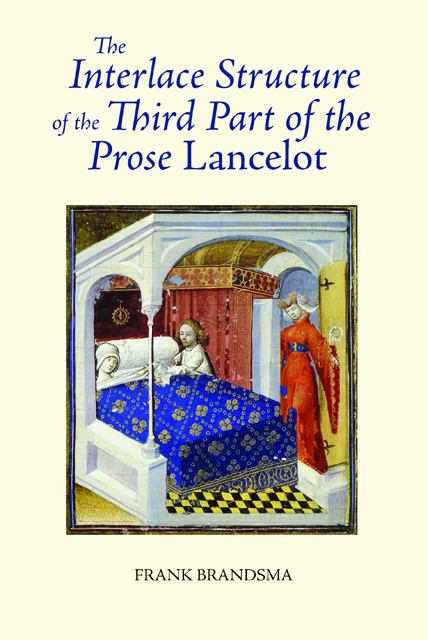Book contents
- Frontmatter
- Contents
- Dedication
- Preface
- Editorial Conventions
- List of Abbreviations
- Plot Summary of the Prose Lancelot and Vulgate Cycle
- 1 Introduction
- 2 Interlace: The Narrative Technique in Lancelot Part 3
- 3 Interlace: The Themes of Lancelot Part 3
- 4 Conclusion: Narration (Revisited) and the Audience
- Appendix 1 Survey of Prose Lancelot Manuscript According to (1) Date and (2) Contents
- Appendix 2 The Interlace of the Primary Narrative Threads in Lancelot Part 3
- Appendix 3 Reading Time
- Bibliography
- Index
- Frontmatter
- Contents
- Dedication
- Preface
- Editorial Conventions
- List of Abbreviations
- Plot Summary of the Prose Lancelot and Vulgate Cycle
- 1 Introduction
- 2 Interlace: The Narrative Technique in Lancelot Part 3
- 3 Interlace: The Themes of Lancelot Part 3
- 4 Conclusion: Narration (Revisited) and the Audience
- Appendix 1 Survey of Prose Lancelot Manuscript According to (1) Date and (2) Contents
- Appendix 2 The Interlace of the Primary Narrative Threads in Lancelot Part 3
- Appendix 3 Reading Time
- Bibliography
- Index
Summary
The Prose Lancelot and interlace have become my lifelong companions in research. Since 1985, I have been fascinated by this rich and complex text, and intrigued by the way the narrative works. So many narrative techniques and strategies still in use today were invented and applied brilliantly in this enormous work of art. Immensely popular throughout the Middle Ages, the Lancelot and the Vulgate Cycle entertained courtly audiences for many an evening of listening to the reading of the parchment pages. The text invites the audience to come up with solutions for the dilemmas placed before the protagonist and other knights. The listeners may have discussed among themselves what Lancelot was to do next, and then the story gave the ultimate courtly answer. I believe that enjoying the Prose Lancelot was a social event, perhaps for a group of ladies and young men, a family, or the community in a castle and perhaps later a townhouse. The final part of my book will explore this issue, after the preceding sections have explained how the interlace works, and what the story is about in the third and final part of the splendid Lancelot tale.
Writing this book would not have been possible without the support and assistance of many friends and colleagues, in the departments of Literary Studies and Dutch Language and Literature at Utrecht University. The Research Institute for History and Culture of Utrecht University has enabled me to devote research time to this project, which has also benefited greatly from a sabbatical leave, financed by the Faculty of Humanities of Utrecht University, in the first semester of the academic year 2007–2008. Wim Gerritsen, Bart Besamusca, Marjolein Hogenbirk, Carol Chase, Ann Rigney, Keith Busby, Martine Meuwese, †Elspeth Kennedy, †Corry Hogetoorn, Petra Kok and Inger and Ruben Brandsma have, each in his/her own way, inspired me, and so have the many students I have worked with in Utrecht and in Jakarta. In the final stages of the making of this book, Barnita Bagchi, Daniel Just and Caroline Palmer have been a great help. I am grateful to the Vinaver Trust and the Utrechtse Stichting voor Literatuurwetenschappelijk Onderzoek for their financial support.
- Type
- Chapter
- Information
- Publisher: Boydell & BrewerPrint publication year: 2010

